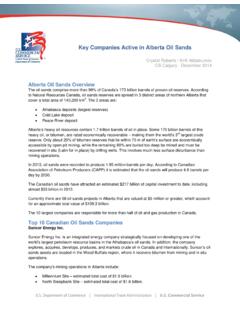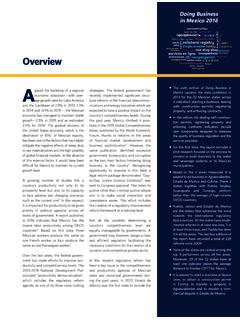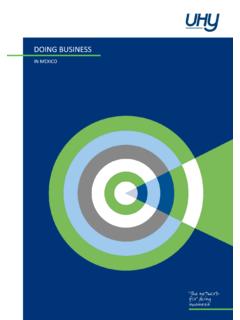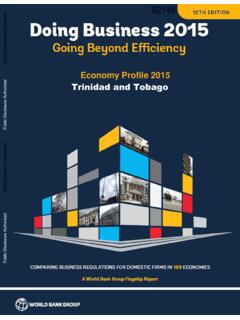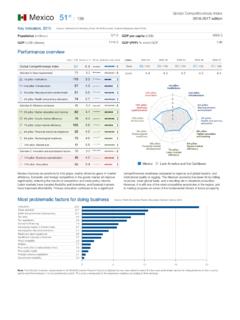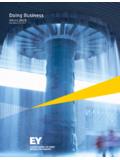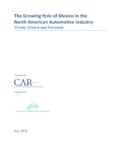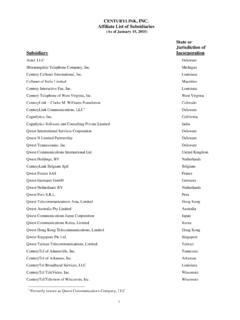Transcription of 2015 - Inicio
1 2015 doing Businessand Investing in doing business and Investing in Peru22015 doing business and Investing in Peru3 Esteban ChongTerritory Senior PartnerPwC Peru ForewordPeru has achieved constant growth in its Gross Domestic Product (GDP) for more than 14 years. Although in 2014, this growth has been significantly less than expected due to a reduction in the activity of the key main sectors of the economy such as mining, construction and manufacturing, there are many expectations regarding the possibilities of achieving improved figures in the next two years. Thus, the Banco Central de Reserva del Per (BCRP) and well known economic specialists, has forecast that GDP growth in 2015 and 2016 will achieve figures between 4% and 5%, terms of foreign trade, Peru is one of the most economically liberalized countries in the region. Additionally, it has a favorable climate for foreign investment. It is worth noting that 85% of exports are made under free trade agreements. Currently, similar agreements are being negotiated or studied with India, Indonesia and Turkey.
2 If they are concluded, practically all of the country s trade will be within the framework of such agreements. In the last decade, Peru s high economic growth was largely based on prices of raw materials, principally minerals like gold, copper, silver, zinc, among others, of which Peru is an important producer. In recognition of the fact that said cycle is coming to an end, the Peruvian State has implemented a series of measures so as to continue to be one of the most attractive countries for foreign investment. Undoubtedly, one of the most significant actions has been the decision to reduce the income tax rate from 30% to 28% for the year 2015 , and progressively to 26% in these measures must also be added the provisions intended to simplify the long and bureaucratic process of prior approvals and revisions of operations of exploration and exploitation of natural resources, as well as infrastructure works. The objective is for said process to be more dynamic and for the phases prior to the start-up of these activities to be completed as quickly as possible.
3 There is still some way to go in this aspect and the leading authorities are showing signs of their concern with facilitating the start-up of a good number of projects that have been delayed. A final aspect to highlight among these efforts is the intention of Peru to form part of the Organization for Economic Cooperation and Development (OECD), a group of countries, mainly developed, which seek to promote public policies which generate wellbeing for their citizens. If these requirements are fulfilled, Peru would become a member of this select group of countries in the medium term. This publication contains the most recent and reliable information on the major macroeconomic, tax, corporate, labor, financial and social matters. We are confident that the contents of this publication will be a very useful tool to help you in your decision-making process to begin doing business and investing in our has more than 90 years of uninterrupted presence in Peru and significant experience providing business advisory services through its multidisciplinary teams, which are always at your service to assist your organization to accomplish its business Country Geography and Political Country risk and investment Major Potencial growth Economic indicators192.
4 business Investment Trade Integrated Latin American Market Pacific Alliance243. Labor Labor Employer s payroll costs in Peru284. Tax Corporate income Withholding Indirect sale of Market value and transfer pricing Stability Income tax on Income tax on individuals: tax Controlled foreign corporations (CFC) Tax treaties in Payroll Financial transactions tax (FTT) Temporary net assets tax (TNAT) Value added tax (VAT) Mandatory Tax Payment System (SPOT) Early recovery of Recovery of VAT on exploration activities for mining and oil & Exporter's positive VAT Excise Customs Customs duties: Drawback regime455. Corporate Incorporating a legal entity in Corporation - Sociedad An Relationships of shareholders, directors and Limited liability company ( ) Branch of a foreign Participation account Consortium or joint venture agreement556. Financial accounting and Application of International Financial Reporting Standars (IFRS) in Major differences between IFRS and Peruvian GAAP587.
5 Environmental and social Social conflicts in Legal framework 2012- Key facts and figures668. Regulatory bodies679. business associations7210. PwC Peru professional services77 Contents2015 doing business and Investing in doing business and Investing in Peru61. Country Geography and climateInfluenced by the Andes Mountains and two marine currents, the Peruvian or Humboldt and El Ni o , Peru is one of the planet s richest geographical environments. It is one of the 17 most bio diverse countries in the world, as a result of its varied ecosystems, climates, wildlife, genetic resources and living ancient is located in the central and western part of South America, its territory includes the 200 miles of territorial waters in the Pacific Ocean and it is the third largest country in South America after Brazil and : 1 285, : Pacific Ocean (Sea of Ecuador), Republic of Ecuador and Republic of : Federative Republic of Brazil and Republic of : Republic of Chile and Pacific Ocean (Sea of Chile).
6 West: Pacific division24 departments. 195 provinces, including the Constitutional Province of Callao. 1,848 historical capital is the city of regions Coast: Comprises of the total area. Consists of a variety of landscapes such as valleys, river deserts, the dry forest of the Northern coastal desert, the mangrove and hillside ecosystems. Highlands: This consists of the Andes Mountain Range. It covers of the national territory. The Andean landscape has a heterogeneous configuration with prominent peaks, deep gorges, narrow interandean vallies and ample plateaus. Jungle: Covers of the national territory and is divided into two areas, the High Forest or Mountain Fringe and the Lowland Forest or Amazonian Plain. The first is characterized by the presence of steep and wooded hills, and deep ravines; the second is covered with exuberant tropical vegetation and large river systems which form part of the Amazon River Basin. Territorial waters: Correspond to the sea adjacent to the Coast, as well as the sea bed and soil up to a distance of 200 nautical miles.
7 BiodiversityPeru is the fourth country in area of tropical forests, the first in the number of plant species of recognized properties and first in domesticated native species. It is also first in varieties of fish, third in amphibians and third in mammals. It has 84 of the planet s 104 life zones, of the world s bird species, of the animal species, of the cultivable plants and 10% of the planet s flora species. The following have been identified: 515 species of mammals, 1,816 species of birds, 418 species of reptiles, 449 species of amphibians, 1,300 species of continental fish and 1,070 species of marine fish; as well as 25,000 species of plants. ClimatePeru has 28 of the 32 types of the world s climates. Source: INEI, MINAM, CPP. Website of the Peruvian doing business and Investing in Political systemPeru is a Presidential Republic with democratic representation and a multi-party system. Its government is based on the separation of powers and it is organized on three levels.
8 In this way, the structure of the State is composed of the Executive Power, the Legislative Power and the Judiciary, as well as seventeen constitutionally autonomous organisms, regional governments and local governments. Furthermore, the fundamental basis of the State legal order is the Political Constitution, which prevails over all legal powerPresident of the RepublicThe President is the Head of State and of the government, his mandate is for 5 years and immediate reelection is not Humala Tasso is the Constitutional President of the Republic until July 28th, of MinistersThis is composed of the President of the Council of Ministers and the ministers, appointed and removed by the President of the Republic. Currently Peru has 18 ministers. Laws issuedLegislative Decrees, Emergency Decrees, Supreme Decrees, Supreme Resolutions, Ministerial Resolutions, Viceministerial Resolutions, Directorial Resolutions and Resolutions of Public powerCongressRepresents the Legislative Power, is unicameral and has 130 congressmen, elected for a 5 year mandate of the current Parliament expires in July issuedLaws and organsThey constitute the Judiciary and have the exclusive power to administer justice.
9 These organs are the Supreme Court, the Superior Courts, Justices of the Peace and the Specialized Mixed Courts. Organs of government and administrationThese consist of the President of the Supreme Court, who is also President and most senior representative of the Judiciary, the Plenary Chamber of the Supreme Court, the Executive Council, General Management and the District Executive Council. Constitutionally Autonomous Organisms They are public law entities with economic, functional, technical and financial autonomy; governed by their organic laws and carry out specialized functions of the State. They include, among others, the Superintendence of Banking, Insurance and Pension Fund Administrators (SBS); the Central Reserve Bank of Peru (BCRP); the Constitutional Tribunal (TC); National Election Administrative Body (JNE) and the National Comptroller s Office. Regional Governments Currently there are 26 Regional Governments, made up of the 24 departments, the Constitutional Province of Callao and the Metropolitan Municipality of Lima.
10 Their representatives are elected by popular vote for four years. Local GovernmentsThey conduct the public administration in each of the provinces, districts and villages of Peru, through the municipalities. Their representatives are elected by popular vote for four years. Source: CPP1. Country overview2015 doing business and Investing in PopulationPeru has the fifth largest population in Latin America, after Brazil, mexico , Colombia and Argentina. The population at June 30th, 2014, is estimated at 30,814,175 people, which signifies an average annual growth of Three quarters of the population lives in urban areas and one quarter in rural areas. By 2021, the Bicentennial Year of Independence, the population is projected to exceed 33 million and by 2050 it will reach 40,111,000 : Population Pyramid, 2014 Forecast 2021 Source: 3% 2% 4%5%1% 1%2%MenAge groupWomen80+75-7970-7465-6960-6455-5950 -5445-4940-4435-3930-3425-2920-2415-1910 -145-90-41. Country overview2015 doing business and Investing in EconomyPeru has been growing impressively during the last decade, and is currently the sixth largest economy in South America, measured by its Gross Domestic Product (GDP) based on Purchasing-Power-Parity (PPP), according to the IMF; and it is also in seventh place of the 20 best countries and frontier markets of the world to invest in, according to Bloomberg Market s Magazine.




